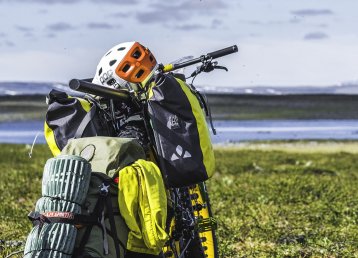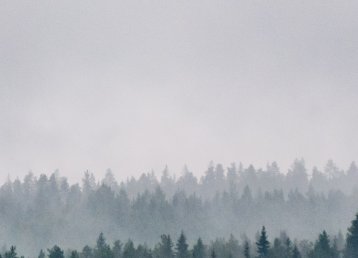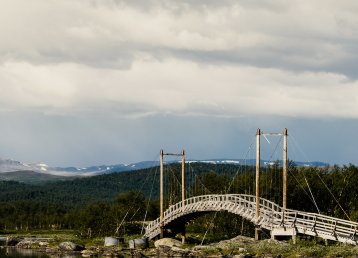Nalovardo, June, at the peak. Without stopping at the turning area by the top cabin, I pedal on along the road that leads to the peak cairn: a kind of mountain stage, or Strava segment, that I have managed. Perhaps that is what it is all about in a way, being able to do something and feel good because of it. Haruki Murakami, often mentioned as a possible recipient of the Nobel Prize in Literature, writes: “I’m at an ordinary – or perhaps more like mediocre – level. But that’s not the point. The point is whether or not I improved over yesterday. […] the only opponent you have to beat is yourself, the way you used to be.”
The blue mountains
At the top, I put on a thin down jacket to keep warm as I stand there. Even if it is a warm and lovely summer day, you will get cold as you stand still and enjoy the view after tens of kilometres uphill. The blue mountains. The clear image of a landscape billowing with forest lines and shadow lines, a delight for the eyes from where I am stood. Swedish poetry, as written by great poets such as Edith Södergran and Dan Andersson, features this kind of yearning. Andersson writes: “There is something beyond mountains, beyond stars and all the blossoms, something too, behind my song, behind this burning heart of mine” and Södergran continues: “I live incessantly in the sweetness of old days among strangers who build new cities on blue hills up against the heaven’s arch”. Blue mountains are a snapshot of the Swedish landscape. I keep my down jacket on as I slowly freewheel down the top of the mountain.

Discover more
The bike can often take you further, to places you otherwise wouldn't experience.
”Almost heaven”
John Denver’s classic song Take Me Home, Country Roads starts in Almost heaven. It is a song of praise to blue mountains, running water and dusty gravel roads. A song about being at home, the home you find in yourself more than in a particular spot. Because, as you probably know, the song is about West Virginia, but John Denver himself had never set foot there when the song was released. It just happened to be a good location for the country crowd. That is why I take the liberty to use some of his lyrics to build this story about biking in Sweden’s Arctic destination: Swedish Lapland. If there is anything we have in abundance, it is blue mountains, winding gravel roads and water. To me and my 21-gear gravel bike, this is almost heaven every day of the week: midnight sun, miles and miles of small roads and little traffic. There are roads here for everyone.
Also read
Under the midnight sunBike roads
In the beginning, everything was a single track. Narrow, trampled forest paths where animals and humans followed the same routes as they migrated between the changing seasons. We walked and then skied until we jumped up on the horse. It would take a long time before the first bike was invented, and even longer for it to make its way to Swedish Lapland. But at the end of the 19th century, the bicycle as we know it made an appearance. Shape-wise not much has changed since then, but the materials are lighter, and they have more gears.
On a path outside Sorsele, a classic example of a so-called ‘bicycle string’, I pedal towards Skålliden nature reserve. At the beginning of the 20th century, a large number of these bike paths were constructed throughout northern Sweden. They mainly ran along river valleys to facilitate log driving. Then there were bike paths leading to areas where trees would be cut down and timber transported out. It is fascinating how mountain bikes originate in 1970s California, where some hippies invented ‘klunkerz’ – modified standard bikes – to start competing downhill. Mainly all these early bikes were made for tough conditions: to carry lumberjacks through the Swedish forest, for example, so that they could do the logging. It was hardly easy going. So, if you like bikes, you will fairly soon realise that you need several of them. All paths and roads are different, waiting to be discovered. That is where I am now, and this time with my fat bike, travelling along an old bike path outside Sorsele, on a journey of discovery along with Swedish cultural history.
A day on the bike
On a few of the many gravel roads in Swedish Lapland.
The Kiruna mountains
I Kirunafjällen, längs E10, där Låktabäcken faller nerför berget i ett magiskt vattenfall, träffar jag två vänner från förr. Världens mest In the Kiruna mountains, along the E10 where Låktabäcken runs down the mountain to create a magical waterfall, I meet up with two old friends: the world’s most published adventure photographer, Mattias Fredriksson, and one of his favourite models, Janne Tjärnström. Janne is from Kiruna, he is very familiar with these mountains. Still he says:
– I didn’t really think the biking around Riksgränsen was as good as what I’ve seen now. Sure, I knew the old Navvy Road had potential, but what’s called the Beer Run in winter is as good on a bike in summer. Biking up and down to Låktatjåkko is a challenge – but perhaps most of all a truly incredible mountain trip.
Mattias, the photographer, has flown in from Canada where he lives these days to do a job for the American bike magazine Bike. He adds:
– I actually don’t think people understand the possibilities and potential of the biking up here.
– I know, nothing is prepared, so it’s like when mountain biking began: it’s basic, but the potential is crazy good.
That is where we find our common ground. In the original. In the untamed wild that is worth discovering.
Traditions and nature
Another completely different day, somewhere beyond the dam at Messaure, in a Strava segment that actually has proper, obvious climbing – just over 100 vertical metres in 2.3 kilometres – I start remembering my age. Rarely something that makes me happy, obviously. The feeling that you used to be something else than you are right now almost always goes hand in hand with age-related complaints. It was not as hard when I was younger. But there is not much I can do about it, or, yes, perhaps there is. That is actually one reason why I started biking again. It is a nice way of going easy on my knees.
But John Denver singing “life is old here” means something other than our own ailments. Traditions and nature. The seldom-travelled gravel roads in this forest were constructed for two reasons. After a while, the bike paths were not enough for the forest work. The machines got bigger, and better roads were needed. Also, roads were made to facilitate the building of hydroelectric power plants in the interior, inhabited by reindeer-herding Sami and settlers. The progress of Swedish society and the rebuilding of a post-war Europe did not take into account anything but natural resources as a Swedish success story. The road network in the middle of nowhere took shape to extract power, ore and wood. Today I take the bike. Not many people greet me on the 100-kilometre trail, but I see a herd of reindeer out on the marshland. They are probably hoping that the afternoon breeze will keep the mosquitoes in check.
Also read
Fly fishing heaven
The road network
The road network in the middle of nowhere took shape to extract power, ore and wood. You won't meet many people out here.
Tailwind and headwind
I am not into biking for fashion. I will admit I do not always have my socks pulled halfway up my calf. I have no idea how to attach the sunglasses to my helmet properly, and no, I do not shave my legs. What I do remember, however, is the first time I learnt how to ride a bike: when uncle Tomas removed the stabilisers and pushed me out on the neighbour’s newly harvested field and I pedalled wildly trying not to lose my balance, and suddenly it just happened. There is a balance in not losing speed. The bike opened up my childhood world. From having been confined to the farmhouse at home, the village was but a certain cadence away. But not just the village, also beaches, fishing spots, friends – with the bike everything got closer. Childhood and my bike would also teach me the difference between tailwind and headwind in life. Sometimes you have one, sometimes the other.
These days I bike differently, perhaps because I live differently. A car is what you use when you are going from a to b. A bike is for exercise and fun, for the experience. The other day I was dropping off a car at Sörbyns Konferens, and instead of waiting for a lift back, I brought my bike. 70 kilometres later, exploring narrow northern roads, I was back in Luleå. Just at the right time to light the barbecue and think about how wonderful summer is, with its eternal white nights. The difference between biking and driving is the difference between using all your senses and not. It does not smell of prepared soil, or haymaking, in the car. The summer mist does not cool your skin as you drive across the river bridge, headwinds and tailwinds are gone, and so is the sound of birds chirping. Experiences are only shortened in time if they are not given the time they deserve. Been there, done that, is no t-shirt print for cyclists.
Autumn
In autumn I am in a bit more of a hurry; sometime in late August, the nights begin filling up with approaching hibernal darkness. The northern lights are back in the sky. Puddles on the bike paths are suddenly frozen: winter is coming. Winters have their own set of biking challenges, for sure. The fat bike works on the network of snowmobile tracks found everywhere in the north, but still, I have to say that there is a sadness in gravel roads covered with snow, making cross-country skiing the natural choice for travelling.
I have a week’s holiday and stay in Sorsele, at the River Hotel. It is the setting of my childhood, where I went to school more than 40 years ago. I have breakfast, and then I mount my bike and go for a ride along a loop I decided on the night before. Somewhere between 50 and 60 kilometres long. Mostly gravel road. Rarely any traffic. Not even the E45, the Inland Route, is very busy in the middle of a September day. But I choose different routes every day and try to capture the advantage of having the opportunity to discover something new. Have you ever been to Marielund, Bockträsk or Aha? Tiny places that are never visited by anyone but those who sometimes wonder why they did not pack up as well, leaving for the city. Time takes its course here. If you end up behind an older man in a cap, perhaps your first thought should not be how quickly you can overtake him. You might want to think about why he is not in a rush to get anywhere. Try to put yourself in his shoes, where the only concern that exists is whether there will be new potatoes in time for the fermented-herring premiere or not. I keep pedalling; I know I will make it back to the hotel before the lunch buffet is over, and I will be hungry then. Tomorrow I will bike up the top of Nalovardo mountain. Just for the view.
Get out there
Rent a bike
Arjeplog
experiencearjeplog.se
Överkalix
explorejockfall.com/
Jokkmokk
hotelakerlund.se
Kiruna
kirunaguidetur.com
bjorkliden.com
Luleå
fatbikeadventures.se
luleaarchipelago.com
Skellefteå
svansele.com

























